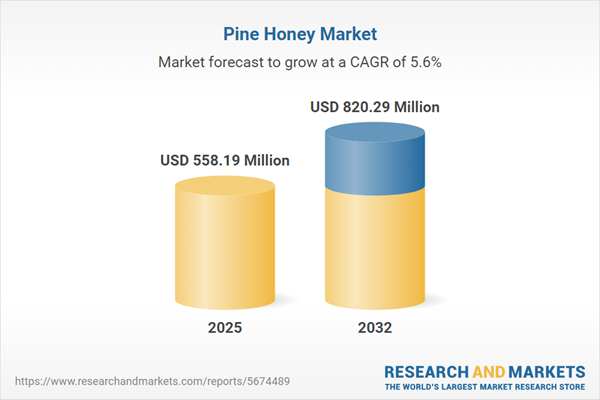Speak directly to the analyst to clarify any post sales queries you may have.
The pine honey market is rapidly adapting to updated consumer expectations and operational challenges, with senior business leaders seeking decisive, data-backed insights to secure growth and resilience. Demand is increasingly shaped by calls for authenticity, enhanced transparency, and advanced supply chain solutions that support value-driven differentiation.
Pine Honey Market Snapshot
The global pine honey market is on a steady upward trajectory, expanding from USD 529.59 million in 2024 to USD 558.19 million the following year, with projected growth to USD 820.29 million by 2032 and a continuous CAGR of 5.62%. This progress is fueled by persistent demand for premium, naturally sourced pine honey, highlighting its strong health and provenance appeal. Producers and distributors are leveraging transparent sourcing and heightened product quality to improve visibility and meet shifting buyer expectations. Enhanced digital marketing and targeted communications are unlocking opportunities in mature regions and fast-growing economies, contributing to the market’s ability to weather diverse global pressures. Notably, the pine honey market demonstrates exceptional flexibility by aligning with cross-industry shifts in wellness, traceability, and digital engagement.
Pine Honey Market Scope & Segmentation
This report equips executive teams with actionable market intelligence to support forward-looking strategy and agile operations. It thoroughly explores the following market segments:
- Product Types: Examines conventional and organic pine honey, enabling clear assessment of certification and food safety standards. Both formats are crucial for buyers focused on trusted sourcing, especially within retail and specialty health sectors.
- Packaging Types: Analyzes prevalent formats such as jars and squeeze bottles, providing insight on how packaging impacts user convenience, shelf appeal, and quality assurance at point of sale.
- Distribution Channels: Reviews all main sales pathways—including supermarkets, hypermarkets, specialty venues, online outlets, and convenience stores—to highlight the accelerating transition to omnichannel models and evolving consumer shopping patterns.
- Applications: Covers uses in food and beverage production, cosmetics, pharmaceuticals, and nutraceuticals, emphasizing pine honey’s value as a multifunctional ingredient and source of health benefits.
- Regional Coverage: Offers clear guidance on market conditions in North America, Latin America, Europe, the Middle East & Africa, and Asia-Pacific, considering regulatory diversity, infrastructure, and local consumer behaviors.
- Notable Companies: Profiles industry leaders shaping sector innovation, such as BEE&YOU by SBS BILIMSEL BIO COZUMLER A.S., Buram GmbH, Capilano Honey Ltd., Comvita Ltd., Dabur India Ltd., Formaggio Kitchen, Honig Schmidt GmbH, Nirra Co., Oliveology Ltd., Queenscent Honey Products, Si Mel Savidakis and Co., Smari Honey, and The Hellenic Deli Ltd.
Key Takeaways for Senior Decision-Makers
- Reinforcing traceability from source to shelf with digital documentation drives trust, brand integrity, and customer retention.
- Biotechnology advancements and novel packaging support nimble scaling without sacrificing quality, enabling faster adaptation to new market dynamics.
- Diverse flavor profiles and perceived wellness benefits continue to open new avenues for both market entry and cross-channel expansion.
- Commitment to sustainable and responsible sourcing underpins regulatory compliance and aligns with growing demands for ethical operations.
- Success drivers differ by geography: established markets offer regulatory clarity, while rapid urbanization in developing regions increases the importance of digital commerce and adaptive retail strategies.
- Strategic investments in technology enhance stakeholder transparency, which is rising in importance as consumers request authenticated origin and process data.
Tariff Impact on Pine Honey Market
Recent U.S. tariff measures are prompting suppliers and distributors to reevaluate sourcing and logistical strategies. Market participants are responding by increasing procurement diversification, adopting consolidated purchasing, and optimizing warehouse processes. Emphasis on differentiated product attributes, such as certification and blending, is bolstering customer loyalty and competitive positioning in the face of these regulatory shifts.
Pine Honey Market Methodology & Data Sources
This research is based on a hybrid methodology that integrates first-hand interviews with producers, processors, and distributors, combined with data from authoritative market reports and academic studies. Meticulous segmentation and rigorous data triangulation produce a detailed view of industry trends and regional developments.
Why This Pine Honey Market Report Matters
- This report supports executive teams in building robust supply chain resilience, identifying rewarding investment areas, and generating future-focused growth strategies tailored to the pine honey market.
- Detailed regional analysis and channel projections prepare stakeholders for compliant global expansion and evolving regulatory landscapes.
- Evaluation of technology adoption and distribution innovations helps executive leadership mitigate risk and drive operational improvements.
Conclusion
This report provides senior decision-makers with the clarity to address challenges, seize new opportunities, and set a strong strategic direction in the evolving pine honey market.
Additional Product Information:
- Purchase of this report includes 1 year online access with quarterly updates.
- This report can be updated on request. Please contact our Customer Experience team using the Ask a Question widget on our website.
Table of Contents
3. Executive Summary
4. Market Overview
7. Cumulative Impact of Artificial Intelligence 2025
List of Figures
Samples

LOADING...
Companies Mentioned
The key companies profiled in this Pine Honey market report include:- BEE&YOU by SBS BILIMSEL BIO COZUMLER A.S.
- Buram GmbH
- Capilano Honey Ltd.
- Comvita Ltd.
- Dabur India Ltd.
- Formaggio Kitchen
- Honig Schmidt GmbH
- Nirra Co.
- Oliveology Ltd.
- Queenscent Honey Products
- Si Mel Savidakis and Co.
- Smari Honey
- The Hellenic Deli Ltd.
Table Information
| Report Attribute | Details |
|---|---|
| No. of Pages | 192 |
| Published | October 2025 |
| Forecast Period | 2025 - 2032 |
| Estimated Market Value ( USD | $ 558.19 Million |
| Forecasted Market Value ( USD | $ 820.29 Million |
| Compound Annual Growth Rate | 5.6% |
| Regions Covered | Global |
| No. of Companies Mentioned | 14 |









